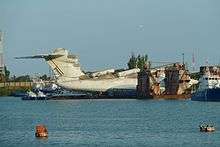Lun-class ekranoplan
Coordinates: 42°52′53″N 47°39′22″E / 42.8815°N 47.6560°E
 MD-160, the sole Lun-class ekranoplan | |
| Class overview | |
|---|---|
| Name: | Lun |
| Operators: | |
| In service: | 1987 – 1995?–1999? |
| In commission: | NA |
| Building: | NA |
| Planned: | NA |
| Completed: | 3 |
| Cancelled: | NA |
| Active: | None |
| Retired: | 1 |
| Preserved: | 1 |
| General characteristics | |
| Class and type: | Lun |
| Type: | Ground effect vehicle transport |
| Displacement: | Displacement n/a, weight 286 tonnes unloaded |
| Length: | 73.8 m |
| Beam: | (Wingspan) 44 m |
| Height: | 19.2 m |
| Draught: | (2.5m 8.2ft) |
| Propulsion: | 8× Kuznetsov NK-87 turbojet engines, 127.4 kN (28,600 lbf) thrust |
| Speed: | 297 kn (550 km/h; 342 mph) |
| Range: | 1,000 nmi (1,900 km; 1,200 mi) |
| Capacity: | 100 tonnes (220,000 pounds) |
| Complement: | six officers and nine enlisted men |
| Sensors and processing systems: | Puluchas search radar |
| Armament: |
|
| Armour: | none |
| Notes: | one built |
The Lun-class ekranoplan (NATO reporting name Duck) is a ground effect vehicle (GEV) designed by Rostislav Evgenievich Alexeyev and used by the Soviet and Russian navies from 1987 until sometime in the late 1990s.[1][2]
It flew using the lift generated by the ground effect of its large wings when close to the surface of the water—about 4 metres (13 ft) or less. Although they might look similar and have related technical characteristics, ekranoplans like the Lun are not aircraft, seaplanes, hovercraft, nor hydrofoils–ground effect is a separate technology altogether. The International Maritime Organization classifies these vehicles as maritime ships.[3]
The name Lun comes from the Russian for harrier.[4]
Design and development

The Lun was powered with eight Kuznetsov NK-87 turbofans, mounted on forward canards, each producing 127.4 kN (28,600 lbf) of thrust. It had a flying boat hull with a large deflecting plate at the bottom to provide a "step" for takeoff.[4] It had a maximum cruising speed of 340 miles per hour (550 km/h).[2]
Equipped for anti-surface warfare, it carried the P-270 Moskit (Mosquito) guided missile. Six missile launchers were mounted in pairs on the dorsal surface of its fuselage with advanced tracking systems mounted in its nose and tail.[5]
The only model of this class ever built, the MD-160, entered service with the Black Sea Fleet in 1987. It was retired in the late 1990s and is now sitting unused at a naval station in Kaspiysk.[2][6][7]
Another version of Lun was planned for use as a mobile field hospital for rapid deployment to any ocean or coastal location. It was named the Spasatel ("Rescuer"). Work was about 90% done, when the military funding ended, and it was never completed.[3][8]
New development
As of 2015, the A-050 ekranoplan is being developed by the Central Hydrofoil Design Bureau, two concepts of which have been shown at the MAKS (air show). According to ValueWalk, the model "will feature modern avionics and navigation", having a take-off weight of 54 tons and carrying capacity of 9 tons; it will be powered by R-195 booster engines, and have a cruising speed of 250 to 300 miles per hour (400 to 480 km/h), with a range of 3,000 miles (4,800 km). At the same time, it is thought the ground effect vehicle will be armed with cruise missiles.[1]
Operators
Specifications
Data from [9]
General characteristics
- Crew: 15 (6 officers, 9 enlisted)
- Capacity: 137 t (302,000 lb)
- Length: 73.8 m (242 ft 2 in)
- Wingspan: 44 m (144 ft 4 in)
- Height: 19.2 m (63 ft 0 in)
- Wing area: 550 m2 (5,900 sq ft)
- Empty weight: 286,000 kg (630,522 lb)
- Max takeoff weight: 380,000 kg (837,757 lb)
- Powerplant: 8 × Kuznetsov NK-87 turbofans, 127.4 kN (28,600 lbf) thrust each
Performance
- Maximum speed: 550 km/h (342 mph; 297 kn)
- Cruising speed: 450 km/h (280 mph; 243 kn) at 2.5 m (8 ft)
- Range: 2,000 km (1,243 mi; 1,080 nmi)
- Service ceiling: 7,500 m (24,606 ft) or 5 m (16 ft) in ground effect
Armament
- Guns: two 23mm Pl-23 cannon in a twin tail turret and two 23mm Pl-23 cannon in a twin turret under forward missile tubes
- Missiles: six launchers for SS-N-22 Sunburn antiship missiles
Related development
- Caspian Sea Monster (KM)
References
- 1 2 Shukla, Vikas. "Russia Revives Its Soviet-Era Ekranoplan Project". ValueWalk. ValueWalk. Retrieved 10 September 2015.
- 1 2 3 Johnson, Robert; Rosen, Armin. "Here's The Astonishing Hovercraft That The Soviets Could Have Used To Invade Western Europe In The 80s". Business Insider. Business Insider. Retrieved 10 September 2015.
- 1 2 Liang Yun; Alan Bliault; Johnny Doo (3 December 2009). WIG Craft and Ekranoplan: Ground Effect Craft Technology. Springer Science & Business Media. pp. 436–. ISBN 978-1-4419-0042-5.
- 1 2 Flying Magazine. July 1994. pp. 72–. ISSN 0015-4806.
- ↑ Ashley Hollebone (31 March 2012). The Hovercraft Story. History Press Limited. pp. 33–. ISBN 978-0-7524-8512-6.
- ↑ Bogodvid, Maksim (27 January 2012). "Russia Revives Production of Flarecraft". RIA Novosti. Retrieved 14 July 2013.
- ↑ Norman Ferguson (1 April 2013). The Little Book of Aviation. History Press Limited. pp. 102–. ISBN 978-0-7524-9285-8.
- ↑ Fast Ferry International. High-Speed Surface Craft Limited. 2003.
- ↑ van Optal, Edwin. "Lun". Netherlands: The WIG Page. pp. The WIG Page Datasheet no. 26. Retrieved 9 June 2012.
External links
| Wikimedia Commons has media related to Lun-class ekranoplan. |
- Lun Ekranoplan on Google Maps
- Wired article on Lun
- Plenty of pictures of Lun, Mirror with English translations of Russian captions